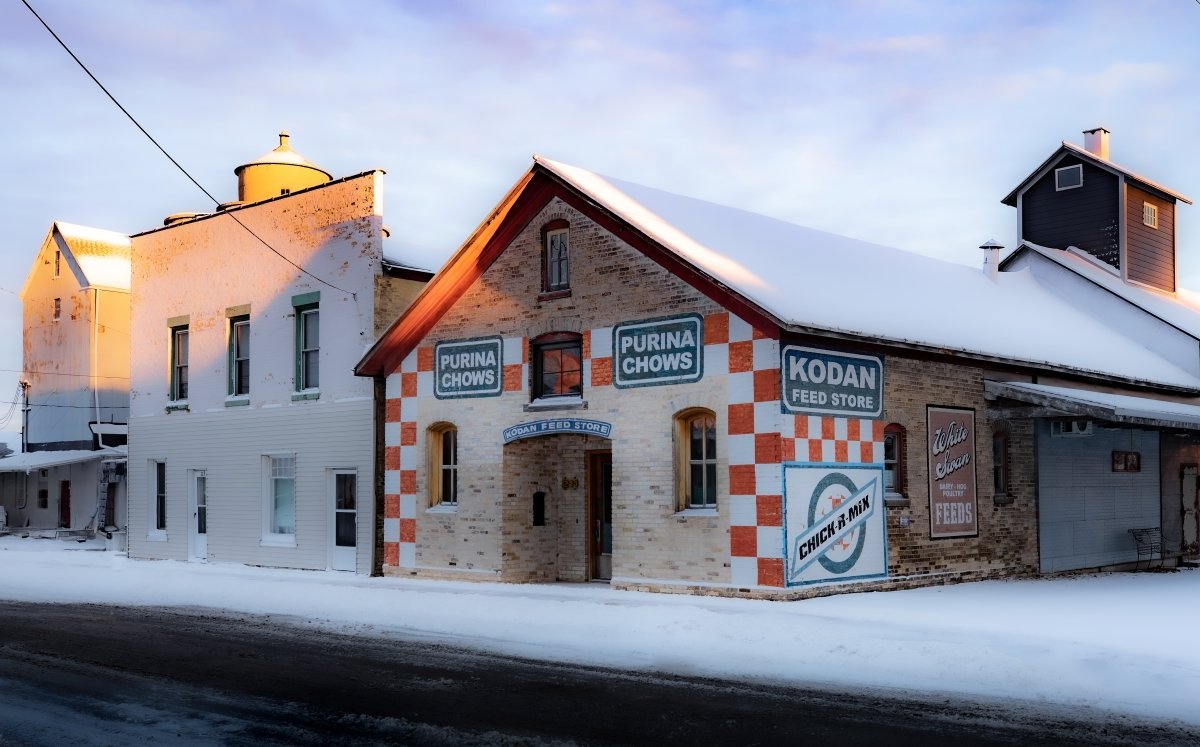"Channeling Edward Hopper in Algoma"
I believe this trio of buildings are the finest remaining representations of 19th century American architecture on the Door peninsula. They span three centuries of commercial activity, are still in use today, and remain relatively unchanged.
[An excerpt from my book Behind The Door: Portraits of a Peninsula]
Eager to tease out a composition, I frequented the site over the course of many months. But nothing I photographed seemed to work. Then after a smothering snowstorm, an entirely new and simplified vision emerged. The snow had quieted the scene eliminating the many niggling distractions: weeds in broken pavement, the dearth of color, and the distracting detail of the roof surfaces. The white blanket provided greater uniformity to the lines and patterns. The geometric shapes became more obvious. Its luminance naturally brightened the image and provided a textural contrast to the dark, hard edges. Behind it all, a pastel sky of blue melancholy and the memory of magenta. The Arcadian scene—accentuated by strongly defined light and shadow, a limited palette, and cropped viewpoints—gave it a somewhat surreal / art deco look reminiscent of paintings by the great 20th century American artist, Edward Hopper.
Go behind-the-scenes on location and discover how I captured this image here: https://youtu.be/dn--bzw-ee8
I believe this trio of buildings are the finest remaining representations of 19th century American architecture on the Door peninsula. They span three centuries of commercial activity, are still in use today, and remain relatively unchanged.
[An excerpt from my book Behind The Door: Portraits of a Peninsula]
Eager to tease out a composition, I frequented the site over the course of many months. But nothing I photographed seemed to work. Then after a smothering snowstorm, an entirely new and simplified vision emerged. The snow had quieted the scene eliminating the many niggling distractions: weeds in broken pavement, the dearth of color, and the distracting detail of the roof surfaces. The white blanket provided greater uniformity to the lines and patterns. The geometric shapes became more obvious. Its luminance naturally brightened the image and provided a textural contrast to the dark, hard edges. Behind it all, a pastel sky of blue melancholy and the memory of magenta. The Arcadian scene—accentuated by strongly defined light and shadow, a limited palette, and cropped viewpoints—gave it a somewhat surreal / art deco look reminiscent of paintings by the great 20th century American artist, Edward Hopper.
Go behind-the-scenes on location and discover how I captured this image here: https://youtu.be/dn--bzw-ee8
I believe this trio of buildings are the finest remaining representations of 19th century American architecture on the Door peninsula. They span three centuries of commercial activity, are still in use today, and remain relatively unchanged.
[An excerpt from my book Behind The Door: Portraits of a Peninsula]
Eager to tease out a composition, I frequented the site over the course of many months. But nothing I photographed seemed to work. Then after a smothering snowstorm, an entirely new and simplified vision emerged. The snow had quieted the scene eliminating the many niggling distractions: weeds in broken pavement, the dearth of color, and the distracting detail of the roof surfaces. The white blanket provided greater uniformity to the lines and patterns. The geometric shapes became more obvious. Its luminance naturally brightened the image and provided a textural contrast to the dark, hard edges. Behind it all, a pastel sky of blue melancholy and the memory of magenta. The Arcadian scene—accentuated by strongly defined light and shadow, a limited palette, and cropped viewpoints—gave it a somewhat surreal / art deco look reminiscent of paintings by the great 20th century American artist, Edward Hopper.
Go behind-the-scenes on location and discover how I captured this image here: https://youtu.be/dn--bzw-ee8
Media: High-Gloss Hahnemühle 100% Cotton Photo Rag Baryta 315gsm fine art paper Ref. No. 10 641 440. Printed on an Epson SureColor P900 inkjet printer at a minimum of 440 dpi resolution, with Epson Ultrachrome PRO10 pigment inks and lustre coat surface finish.
Fine Art Photographic Print created using the highest quality archival components available to ensure longevity. With proper care it should last for generations. The artist offers prints in an authorized signed, dated, numbered, and size-limited edition of 25 images. The artist’s signature on the CoA attests that each has been personally photographed, post-processed, individually printed, inspected, controlled, approved, and numbered by the artist. There are no unauthorized, unsigned and/or unnumbered prints. The original digital file has not been destroyed. Artist reserves the right to reproduce images in other limited edition sizes and outside the limited edition series in books, magazines, press cards, and for licensing. Additional media and custom sizes available upon request.
All intellectual property rights to the image are fully retained by the artist. Any unauthorized copies or use is in violation of United States Copyright Law.


